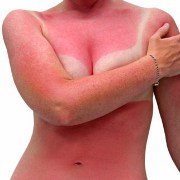 Photo: Getty Images
Photo: Getty Images
Warmer weather is finally here and it feels so luxurious to linger outside and soak up some rays. Many years ago, people used to stay out in the sun as long as possible and even rubbed baby oil on their skin to hasten getting a tan. Today, we know better. We obediently rub sunscreen on our skin and are told to continue this practice even in the winter but sometimes we forget. We know we are supposed to avoid over exposure to the sun but what exactly is a sunburn and what happens afterward?
The sun radiates UV (ultraviolet) light. The UV light comes in contact with the outer layer of our skin, the epidermis, and exposes the cells to radiation. The radiation comes in contact with melanin in this outer layer of skin, which can only absorb some of the damaging rays. People with darker skin have more melanin and can withstand greater exposures to UV light than those with lighter colored skin.
In small amounts, exposure to UV light causes the melanin to react so our skin develops a tan. However, further exposure to the radiation affects the deeper layers of cells in the epidermis and damages them. This intense exposure to UV radiation causes a burn.
This sunburned layer of skin cells becomes red, hot and may blister and those cells now damaged will die off. The skin also swells as our immune system responds to the death of those cells and increases blood flow to the area. The damaged cells also release other chemicals that cause our nerve endings to be more sensitive and the skin becomes exceptionally painful to touch. These are the familiar sensations of a sunburn.
Later comes peeling of that damaged layer. The dead cells on the outer layer of your skin progressively lose moisture, dry up and at some point will begin to peel away. Before they peel, they provide a protective layer to the new cells underneath which will replace the damaged ones. The new cells are very sensitive and vulnerable to the damaging rays and must be protected to prevent the cycle from occurring again. It is doubly important to wear sunscreen at this time and/or clothing to cover the newly formed skin.
It is easy to forget how damaging the suns rays can be. Skin damage is also cumulative. Continued sunburn episodes make it more difficult for our skin to recover and increase our susceptibility to developing skin cancer. Don’t let the lure of the skins rays cause you to forget your sunscreen or keep you from going inside long before you notice the beginnings of a burn.
Sources:
http://health.howstuffworks.com/skin-care/beauty/sun-care/question637.htm
http://skincancer.dermis.net/content/e02factors/e141/index_eng.html
http://peer.tamu.edu/curriculum_modules/OrganSystems/module_1/hazards.htm
http://www.wisegeek.com/why-does-my-skin-peel-after-a-sunburn.htm
Edited by Alison Stanton
Michele is an R.N. freelance writer with a special interest in woman’s health care and quality of care issues. Other articles by Michele are at www.helium.com/users/487540/show_articles





Add a CommentComments
There are no comments yet. Be the first one and get the conversation started!